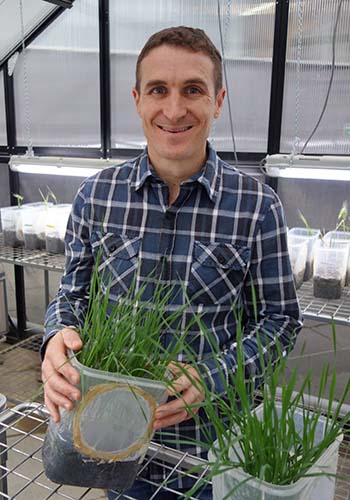Resistance management strategies for important grain pests provide growers with tactics to manage resistance and delay the evolution of further resistance.
Several economically important invertebrate pests in the grains industry have already evolved insecticide resistance. Recent industry trends, such as the widescale use of insecticide seed treatments, are placing additional selection pressure on pests to evolve new resistances, meaning the issue can no longer be ignored.
Challenges
Insecticide resistance has been identified in several important invertebrate pests of grains, including cotton bollworm, diamondback moth, green peach aphid, redlegged earth mite and the silverleaf whitefly.
 Paul Umina says industry management strategies have produced a range of pests. Photo: cesar
Paul Umina says industry management strategies have produced a range of pests. Photo: cesar
Importantly, there has been an increase in resistance issues, highlighted by the recent detection of pyrethroid resistance in redlegged earth mites in South Australia and the evolution of neonicotinoid resistance in green peach aphids.
Central to insecticide resistance management is the rotation of insecticides from different Mode of Action (MoA) groups and the adoption of integrated pest management (IPM).
But grain growers often have few options for rotation, relying heavily on Group 1 (carbamates 1A and organophosphates 1B), Group 3A (pyrethroids) and Group 4A (neonicotinoids) insecticides.
The use of some of these chemical groups is under threat due to regulatory reviews, future changes to maximum residue limits and the withdrawal of product support by manufacturers. With relatively few new insecticide products in the market pipeline, growers options will remain limited.
Resistance management strategies are available for cotton bollworm, diamondback moth, green peach aphid and redlegged earth mite.
Additionally, these chemical groups are mostly broad spectrum and harmful to many non-target insects, including beneficials, and therefore disruptive to IPM.
Strategies
The over-reliance on insecticides will continue to place selection pressure for resistance. This is likely to result in further insects evolving resistance and/or existing species evolving resistance to a broader range of insecticide MoAs.
Researchers can estimate the likely evolution of chemical resistance in invertebrate pests using a combination of biological information about the species and knowledge of current agricultural practices (that is, selection pressures).
For some pests, the risk of resistance evolving is low. But others seem much more likely to evolve insecticide resistance. It is important that a diversity of pest management practices is used to limit this future threat.
GRDCs National Insecticide Resistance Management working group and CropLife Australias Insecticide Resistance Management Review Group has developed resistance-management strategies specifically for the grains industry - covering cotton bollworm, diamondback moth, green peach aphid and redlegged earth mite.
Growers can download these strategies via the GRDC website or the IPM Guidelines for Grains website.
Strategy principles
Resistance management strategies are available for cotton bollworm, diamondback moth, green peach aphid and redlegged earth mite.
Before spraying:
- Use cultural methods to reduce pest numbers (for example, eliminating the green bridge prior to sowing).
- Monitor pest and beneficial populations to decide if chemical control is warranted and use economic thresholds to guide decisions about spray applications.
- It is important to identify the pest correctly. Misidentification and incorrect insecticide selection can result in poor control and will contribute to selection for resistance.
The decision to spray:
- Encourage beneficial insects by avoiding broad-spectrum insecticides (especially pyrethroids and organophosphates). Instead use target-specific soft chemicals, such as pirimicarb or sulfoxaflor for aphids and Bt or virus for caterpillars.
- Follow recommended label rates.
- Make sure spray coverage is effective, particularly in bulky crops such as canola.
Re-spraying:
- Avoid repeated applications of products from the same insecticide MoA group per generation.
- Never re-spray in the same season with the same MoA group after a suspected spray failure.
More information: Dr Paul Umina, cesar, 0405 464 259, pumina@cesaraustralia.com; IPM for Grains insecticide resistance management strategies

























































